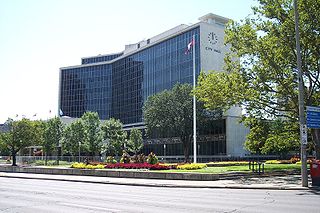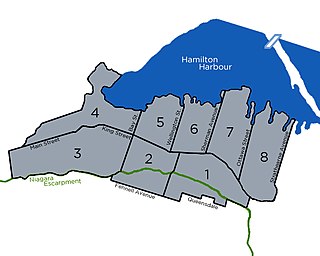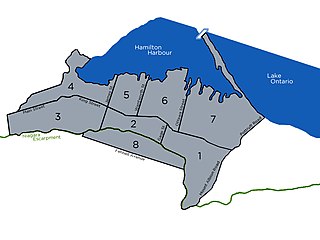
Larry Di Ianni is an Italian-Canadian politician and educator who served as the 54th mayor of Hamilton from 2003 to 2006. Prior to his tenure as mayor, he served as a town councillor in Stoney Creek and a city councillor in the amalgamated City of Hamilton.
Elections in the Philippines are of several types. The president, vice-president, and the senators are elected for a six-year term, while the members of the House of Representatives, governors, vice-governors, members of the Sangguniang Panlalawigan, mayors, vice-mayors, members of the Sangguniang Panlungsod/members of the Sangguniang Bayan, barangay officials, and the members of the Sangguniang Kabataan are elected to serve for a three-year term.

The 2003 Hamilton municipal election was held on November 10, 2003, to elect municipal officials in Hamilton, Ontario. On election day, Hamiltonians elected a mayor, 15 city councillors, and trustees for the Hamilton-Wentworth District School Board, Hamilton-Wentworth Catholic District School Board, Conseil scolaire Viamonde, and Conseil scolaire catholique MonAvenir.

The 1985 Hamilton municipal election was held on November 12, 1985 to elect a Mayor, sixteen members to Hamilton, Ontario City Council, fourteen members to the Hamilton Board of Education and sixteen members to the Hamilton-Wentworth Roman Catholic Separate School Board. In addition, this election was accompanied by a referendum question asking voters if they wanted to directly elect individuals to the office of Regional Chairman.

Politically, Hamilton is known for producing groundbreaking, colourful and left-wing politicians. Locally, though, the big political stories have included the controversial amalgamation of Hamilton with its suburbs in 2001, the destruction of green space around the Red Hill Valley to make way for the Red Hill Creek Expressway, and plans to build a Light Rail Transit line in the city.

Robert Bratina is a Canadian politician and former broadcaster who was the 56th mayor of Hamilton from 2010 to 2014. Previously, he sat on the Hamilton City Council from 2004 until 2010. He went on to be the Liberal member of Parliament for the riding of Hamilton East—Stoney Creek from 2015 to 2021.
The 2000 Hamilton municipal election was a municipal election held on November 13, 2000, to elect municipal officials for the City of Hamilton. On election day, Hamiltonians elected a mayor, 15 city councillors, and trustees for the Hamilton-Wentworth District School Board, Hamilton-Wentworth Catholic District School Board, Conseil scolaire Viamonde, and Conseil scolaire catholique MonAvenir. This was the first election of the "New" City of Hamilton after the dissolution of the Region of Hamilton-Wentworth and the amalgamation of Dundas, Stoney Creek, Flamborough, Ancaster, Glanbrook, and Waterdown with the existing city of Hamilton.

The 1997 Hamilton municipal election was a municipal election held on November 10, 1997, to elect municipal officials for the City of Hamilton. Hamiltonions selected one mayor, one regional chairperson, and seventeen members of the Hamilton City Council, who were elected on a two-tier basis, as well as members of both the English and French Public and Catholic School Boards. The suburban communities of Ancaster, Flambrough, Glanbrook, Dundas and Stoney Creek, each elected town councils for the last time before amalgamation.
Okotoks-High River was a provincial electoral district in Alberta, Canada, mandated to return a single member to the Legislative Assembly of Alberta from 1930 to 1971.
The Labor-Progressive Party was the legal front of the Communist Party of Canada and several provincial wings of the party from 1943 to 1959.

The 1944 Hamilton municipal election was held on December 4, 1944 to select one Mayor, four Controllers, and sixteen members of the Hamilton, Ontario City Council. Voters also elected one member per-ward to the local Public School Board for a two-year term.

The 1946 Hamilton municipal election was held on December 9, 1946, to select one Mayor, four Controllers, and sixteen members of the Hamilton, Ontario City Council, as well as members of the local Board of Education. Held immediately following the 1946 Stelco strike, the election set a record for voter turnout, with 65.1% of eligible voters casting a ballot.

The 2014 Hamilton municipal election was a municipal election that occurred on October 27, 2014, to select one mayor, fifteen members of the Hamilton City Council and members of both English and French Public and Catholic School Boards. As per the Ontario Municipal Elections Act, nominations opened on January 2, 2014, and closed on September 12, 2014. Four new councillors were elected in open seats across Hamilton while all incumbents who stood for re-election had returned to office. Though marked by a steep decline in voter turnout, this election was historic, as it saw the election of Hamiton's first openly gay and first racialized members of city council.

The 1950 Hamilton municipal election was held on December 6, 1950, to select one Mayor, four Controllers, and sixteen members of the Hamilton, Ontario City Council, as well as members of the local Board of Education. In addition, this election was accompanied by six referendums, each dealing with a major issue in the city at the time.

The 1932 Hamilton municipal election was held on December 5, 1932 to select one Mayor, four Controllers, and sixteen members of the Hamilton, Ontario City Council, two from each of the city's eight wards. Voters also cast ballots for trustees for the public school board.

The 1933 Hamilton municipal election was held on December 4, 1933 to select one Mayor, four Controllers, and sixteen members of the Hamilton, Ontario City Council, two from each of the city's eight wards. Voters also cast ballots for trustees for the public school board.

The 1934 Hamilton municipal election was held on December 3, 1934, to select one Mayor, four Controllers, and sixteen members of the Hamilton, Ontario City Council, two from each of the city's eight wards. Voters also cast ballots for trustees for the public school board.
The 1930 Hamilton municipal election was held on December 1, 1930 to select one Mayor, four Controllers, and sixteen members of the Hamilton, Ontario, City Council, two from each of the city's eight wards. Voters also cast ballots for trustees for the public school board.

The 2018 Hamilton municipal election was a municipal election that occurred on October 22, 2018, as per the Ontario Municipal Elections Act, 1996. Residents of Hamilton selected one mayor, members of the Hamilton City Council, and members of both the English and French Public and Catholic School Boards.
The 1927 Hamilton municipal election was held on December 5, 1927 to select one Mayor, one Hydro Commissioner, four Controllers, and sixteen members of the Hamilton, Ontario, City Council, two from each of the city's eight wards. Voters also cast ballots for trustees for the public school board, and in two bylaw referendum questions regarding an expansion to Hamilton's General Hospital and the city's sewer system.







